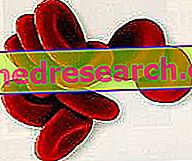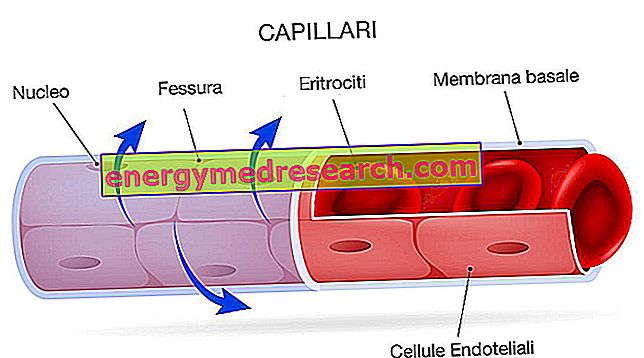Normal red blood cell development
The development of blood cells is called hematopoiesis, while the specific one of red blood cells or erythrocytes is called erythropic.
Bone marrow, lymph nodes and spleen are all organs involved in hematopoiesis. Traditionally they stand out:
- a myeloid tissue, including the bone marrow and the cells that originate from it: red blood cells, platelets and granulocyte-monocytes (white blood cells).
- a lymphoid tissue, consisting of thymus, lymph nodes, spleen and the cells that originate from them: the B and T lymphocytes.
The mature elements of the blood all originate from a single hematopoietic stem cell, called multipotent because it represents the common precursor from which all blood cells can be derived indiscriminately. Lymphoid stem cells (which will give life to lymphocytes) and myeloid stem cells related to the three medullary lines (erythrocytes, granulocytes - monocytes and platelets), destined respectively to the production of lymphocytes and myeloid cells, subsequently develop.

The commissioned stem cells of the erythroid line are the first progenitors sensitive to erythropoietin (Epo), a protein produced by the kidney, whose action is essential for the development and maturation of red blood cells.
The renal cells are equipped with a sensor for the quantity of oxygen and, based on the degree of hypoxia (reduction of oxygen) of the blood that irrigates them, they regulate the secretion of erythropoietin. This hormone, by binding to a receptor of erythroid cells, determines in them a response which consists in the increase of their division, of the synthesis of hemoglobin (the iron-protein which is contained in red blood cells and which binds oxygen) and of receptors for transferrin (the protein that binds iron and transports it into the bloodstream).
The mature red blood cell, to become such, must follow some maturational stages:
- Proeritroblasto
- Basophilic Erythroblast
- Polyromatophilic Erythroblast: begins to synthesize Hemoglobin
- Orthochromatic Erythroblast: expels the nucleus contained within it (red blood cells are cells without a nucleus!)
- Reticulocyte: leaves the bone marrow and enters the bloodstream
- Mature erythrocyte.
Erythrocyte structure
The red blood cell is a cell with an outer membrane and cytoplasm, but without a nucleus and cytoplasmic organelles. The completely differentiated erythrocyte, in practice, is formed only by a plasma membrane that contains hemoglobin and a limited number of enzymes, necessary for maintaining the integrity of the membrane and for the function of transporting gases. Its color is pink, due to its high hemoglobin content, which is basic, ie it binds acid dyes which are pink in themselves.
Its shape is a "biconcave disk"; this determines a greater surface area than the spherical shape, and this allows to significantly increase gas exchange.
The fluidity of the membrane allows the erythrocyte to deform easily, so that it can also pass through the smallest capillaries.
Hemoglobin is a protein formed by four polypeptide chains (of many amino acids) that are two by two equal: two alpha chains and two beta chains. Each chain binds a heme radical, which is a structure capable of binding an iron molecule. Thus a hemoglobin molecule, which contains four heme radicals, is capable of binding four iron molecules. Iron binds oxygen; from this we deduce that hemoglobin is a protein capable of binding oxygen and of transferring it to tissues in physiological conditions, according to their needs.
Red blood cell function
Red blood cells have a main function which is to transport oxygen to tissues. The aspect (morphology) assumed by the erythrocytes under examination of the peripheral blood smear (blood is taken from the subject, is crawled on a slide and is looked at by the optical microscope) is very important:
The size of erythrocytes: normocytes (normal size), microcytes (diminished), macrocytes (increased)
The degree of hemoglobinization, which is reflected in the color of erythrocytes: normochromic or hypochromic (lighter).
The form of erythrocytes
These values are also objectively measured and are called erythrocyte indices. In most laboratories there are instruments that measure them directly or calculate them automatically. They are:
MCV or average corpuscular volume : it is the volume of a red blood cell, expressed in phentoliters (cubic micrometers). Normal values are considered to be those between 80 and 95 phentoliters. An anemia is called microcytic when MCV is below the normal range and macrocytca when MCV is higher.
MCH or mean corpuscular hemoglobin : is the average content (mass) of hemoglobin per red blood cell, expressed in picograms. Normal values are between 27 and 33 picograms.
MCHC or average corpuscular concentration of hemoglobin : it is the average concentration of hemoglobin in a given volume of sedimented red blood cells, and is expressed in grams per deciliter. Normal values are between 33 and 35 grams per deciliter.
RDW or Width of distribution of red blood cells : it is the coefficient of variation of erythrocyte volume. Normally it is between 11% and 14%.
Reference values
The average normal values of red blood cells in the blood vary according to sex, but also according to the various races and age
| Reference population | Average values (Miale) per mm3 of blood |
| Adult white males | 4, 800, 000 |
| Adult white females | 4, 300, 000 |
| Adult black males | 4, 400, 000 |
| Adult black females | 3, 800, 000 |
| Children and the Elderly | Compared to adults, the value is about 3-400, 000 units lower. |
Therefore also the normal intervals adopted by the various analytical laboratories may vary. As an indication, the following normal ranges can be taken as a reference
- adult males: 4.5-6 million / mm3 (4.500.000-6.000.000 / mm3)
- adult women: 4-5.5 million / mm3 (4, 000, 000-5, 500, 000 / mm3)
DID YOU KNOW: The different concentration of red blood cells and hemoglobin in the two sexes is due to the greater presence of testosterone in the male organism. This powerful anabolic hormone stimulates erythropoiesis, which is the formation of new red blood cells.



